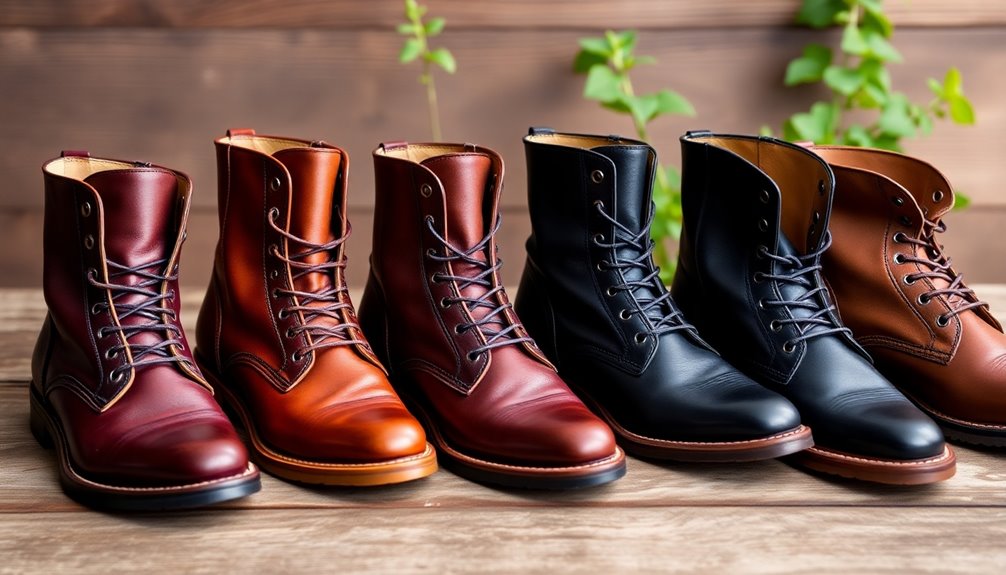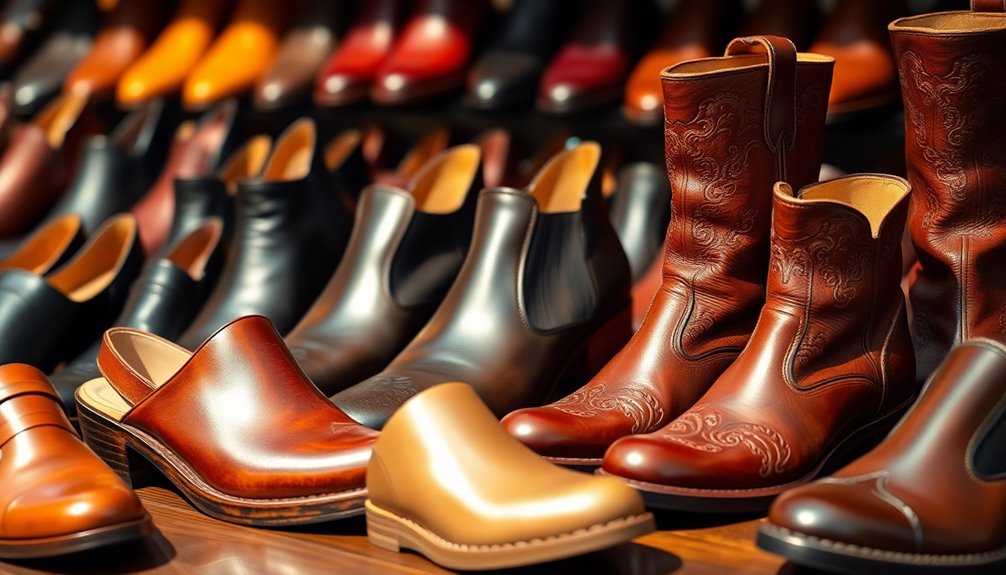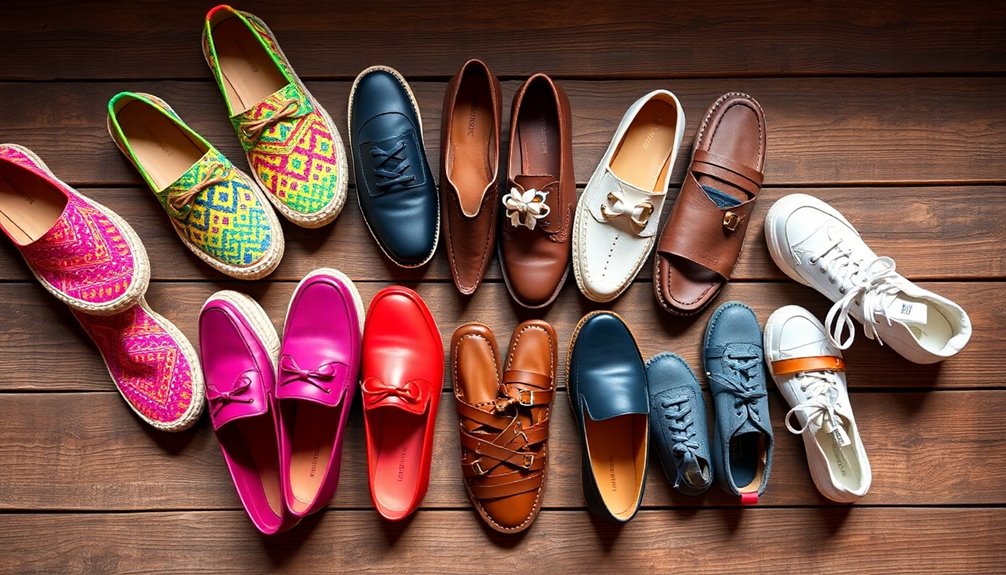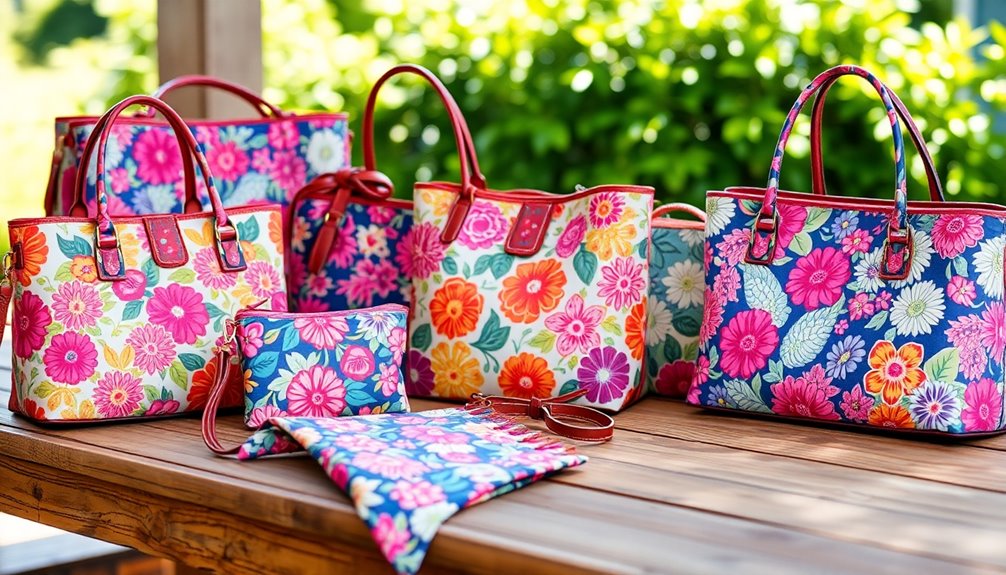When you're searching for Dutch boots, you can't go wrong with brands like Floris van Bommel and Fred de la Bretoniere. These names stand out for their historic roots and commitment to quality. Opt for VIA VAI or Nubikk if you prefer trendy styles without sacrificing durability. Look for features like full-grain leather and Goodyear welt construction to ensure your boots last. With proper care, they'll maintain their appeal season after season. Whether you're dressing up or down, Dutch boots are versatile. Stick around to discover more about the best options suited for your style and needs.
Key Takeaways
- Dutch boot brands like Floris van Bommel and Fred de la Bretoniere offer a rich heritage and exceptional craftsmanship in stylish footwear.
- Quality materials such as full-grain leather and Goodyear welt construction ensure durability and comfort in every pair of boots.
- The designs blend traditional elements with modern aesthetics, appealing to consumers seeking unique and fashionable options.
- Brands like Bata Industrials and Gerba B.V. provide specialized footwear for various needs, from military to safety boots, without compromising style.
- With seasonal adaptability and waterproof options, Dutch boots are versatile choices for both casual and formal occasions.
Overview of Dutch Boot Brands
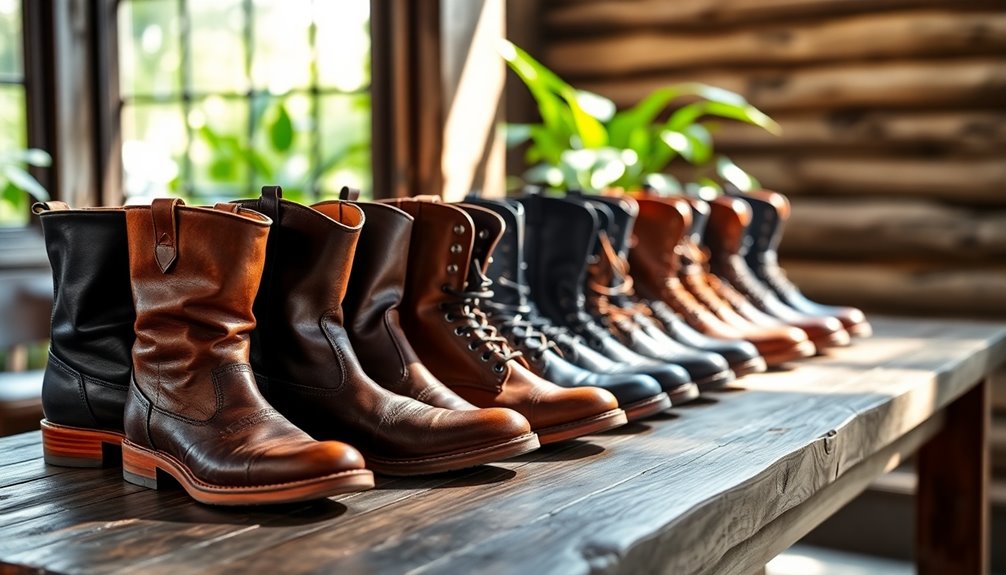
Exploring the diverse landscape of Dutch boot brands reveals a rich tapestry of history, style, and innovation.
You'll find historic brands like Floris van Bommel, which boasts over 280 years of craftsmanship, delivering high-quality men's shoes and sneakers. Fred de la Bretoniere, established in 1970, caters to women seeking stylish workplace footwear. The Dutch shoe industry is recognized for its emphasis on durability and aesthetic appeal.
Meanwhile, Bata Industrials has a long-standing reputation for military and occupational footwear, including the Dutch army's M90 boots.
If you're leaning towards trendy options, brands like VIA VAI and Nubikk stand out. VIA VAI creates hip designs that include sandals and ankle boots, while Nubikk targets young adults with luxury sneakers.
ETQ Amsterdam offers minimalist sneakers at competitive prices, making them accessible for many.
For specialized tastes, Bootstock specializes in handmade cowboy boots with a bohemian flair and caters to women and children. Gerba B.V. focuses on safety boots that meet European standards, showcasing how brands adapt to niche markets.
Together, these brands reflect the richness of Dutch design, ensuring there's a perfect boot for everyone, whether you prioritize style, history, or functionality.
Quality Materials for Durability
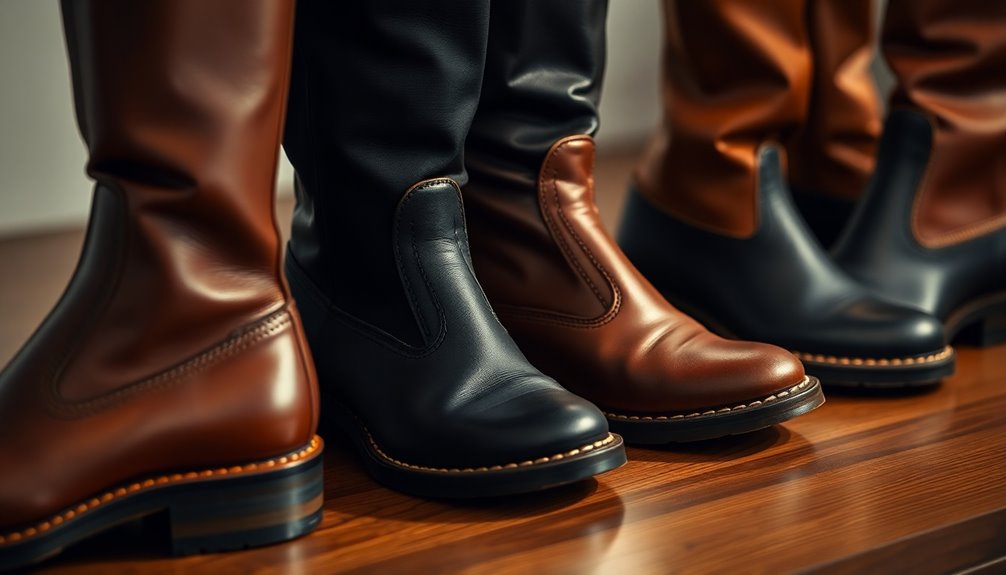
When it comes to durability in Dutch boot brands, the choice of materials plays a crucial role. High-quality leather, particularly full-grain leather, stands out as the best option. Known for its strength, this leather retains natural textures and develops a unique patina over time. It breathes well, keeping your feet cool and dry, while also resisting water and stains. As it molds to your foot shape, it offers maximum comfort. Additionally, investing in quality boots can lead to significant long-term savings due to their durability and reduced replacement frequency.
The construction methods significantly impact durability too. Goodyear welt construction is a top choice, allowing for sole replacement and extending your boots' life. Blake stitched construction offers flexibility and affordability, while cemented construction, though budget-friendly, is the least durable.
Don't overlook other key materials like rubber outsoles, which provide excellent durability and slip resistance, or polyurethane (PU) outsoles, ideal for urban environments. Midsoles made from EVA or PU enhance comfort and durability, while steel shanks add extra support.
Longevity and Care Tips
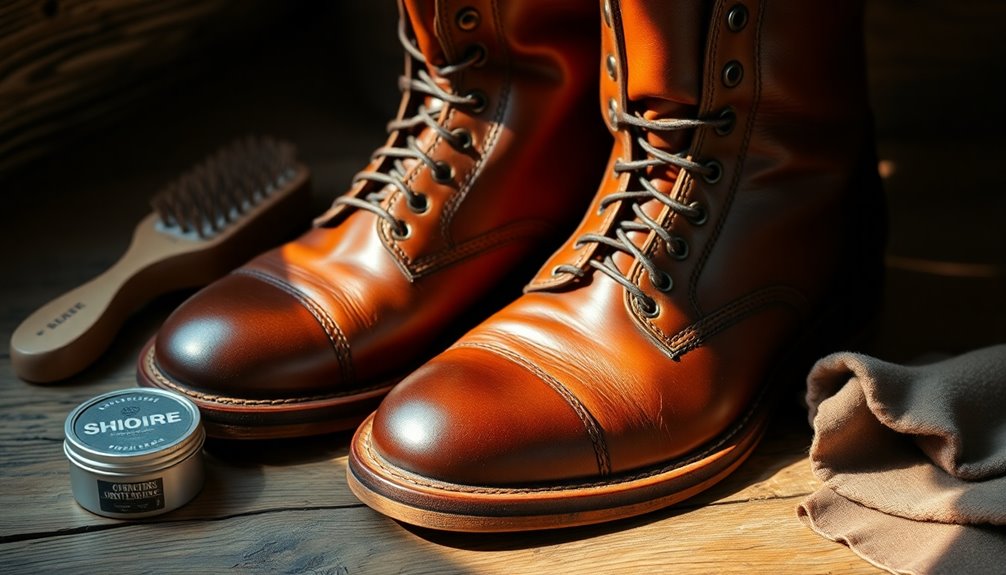
To ensure the longevity of your Dutch boots, proper care is just as important as the quality materials used in their construction. Start by protecting your boots from the elements. Use waterproofing sprays or oils to shield the leather from water, snow, and dirt. Avoid direct sunlight or heat, which can cause fading and cracking. Applying products like Dr. Martens' Wonder Balsam can enhance water resistance. Additionally, regular protection against rain and spills is essential for preventing long-term damage.
Cleaning your boots regularly is crucial. Remove surface dirt with a soft cloth or brush to prevent scratches. For deeper cleaning, use mild soapy water or leather cleaners, steering clear of harsh chemicals. Pay special attention to tricky areas around the eyelets with a toothbrush.
Conditioning and polishing your boots every 3-4 months will maintain their softness and prevent cracking. Use premium leather conditioners to restore natural oils, massaging it into the leather, then buff with a horsehair shine brush for a polished finish.
Finally, store your boots in a cool, dry place away from sunlight. Use acid-free paper or boot trees to maintain their shape, and regularly remove inner soles to allow for air circulation.
Following these tips will keep your Dutch boots looking great for years to come.
Styling Options and Versatility

Dutch boots are incredibly versatile and can elevate a wide range of outfits, from casual to formal. For a laid-back vibe, pair your boots with jeans and a simple t-shirt, or throw on a cozy sweater or fleece gilet. Earthy tones and classic country prints like plaid enhance the look, while accessories such as wide-brimmed hats and statement belts add flair.
On rainy days, layer with waterproof jackets and trousers to keep stylish and dry. The waterproof protection of these boots ensures that your feet stay warm and dry even in the harshest weather conditions.
If you're aiming for a more polished appearance, wear your boots with a flowy dress or a skirt and blouse combo. Choose a dress that hits just above the knee to showcase the boots. Layer with cardigans or leather jackets when it's chilly, and add blazers to elevate the outfit.
When considering proportions, balance your silhouette by mixing looser pieces with fitted tops. For colder weather, knee-high boots pair beautifully with chunky sweaters and long wool coats.
Don't forget about material and color—suede works well for daytime, while leather offers versatility. Stick to a cohesive color palette to ensure your boots complement your overall ensemble seamlessly.
Market Trends and Popularity
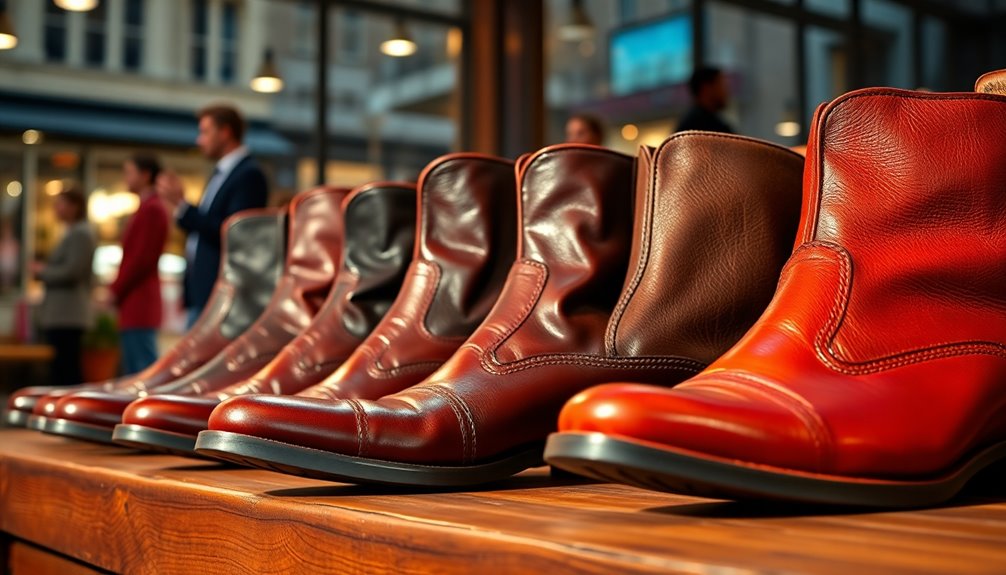
As you explore the versatility of Dutch boots, it's important to consider the market trends shaping their popularity. Consumer behavior plays a significant role, as lower confidence leads to more prudent spending among Dutch shoppers. While men tend to spend more on clothing, women dominate the footwear market, driving demand for stylish yet affordable options. The growing population, bolstered by immigration, expands this consumer base, especially for eco-friendly and unique vintage pieces, fueling the second-hand apparel trend. Rising competition from second-hand and vintage apparel markets is also influencing consumer choices. Additionally, the preference for durability and safety in toy selection influences purchasing decisions in various product categories, including footwear.
International brands are also influencing the market, gradually consolidating the footwear landscape. These brands invest heavily in advertising and stay updated on fashion trends, leveraging their quality and innovative designs to maintain brand recognition.
Digital shopping is transforming how you buy boots, with online convenience becoming a priority. Retailers are adopting an omnichannel approach, merging online and in-store experiences. This hybrid model meets your desire for easy online shopping while still offering the tactile experience of trying boots in person.
Despite recent challenges, the Dutch footwear manufacturing industry is projected to grow, reflecting a steady interest in quality footwear, including Dutch boots, amidst economic fluctuations.
Innovative Design and Heritage

Innovative design in Dutch boots marries heritage with modern aesthetics, creating footwear that resonates with both tradition and contemporary trends.
You'll notice the use of premium materials like luxury leather and high-quality woods such as alder and beech, which ensure durability and style. This commitment to craftsmanship is evident in the Goodyear-welted construction, providing long-lasting comfort. AI technologies can also play a role in enhancing the design process, ensuring precision and personalization in each pair.
The cultural influence is strong, drawing inspiration from Dutch heritage and the resilience of strong-willed women. Traditional wooden clogs have evolved, merging historical roots with fashionable designs, including modern espadrilles and winter sneakers. This fusion highlights how the past can inform the present while embracing new technologies for enhanced comfort, such as the evolution of product lines.
Attention to detail is paramount, with intricate patterns and exclusive materials like Shell Cordovan making each pair unique.
These boots not only reflect Dutch culture but also adapt to various seasons and uses, ensuring they remain practical.
As you explore Dutch boots, you'll find that they beautifully encapsulate the essence of tradition while boldly stepping into the future, making them a standout choice for anyone seeking style and durability.
Frequently Asked Questions
What Is the Price Range for Dutch Boot Brands?
When you're looking at Dutch boot brands, you'll find a range of prices.
For high-end options, expect to pay between €319.95 and €369.95 for brands like Shabbies Amsterdam. Mid-range boots typically fall between €200 and €400, while budget options are usually under €200.
Keep in mind that the prices often reflect the materials and craftsmanship, so you might want to invest a bit more for quality and durability.
Where Can I Buy Dutch Boots Online?
You can buy Dutch boots online from several reliable sources.
Check out the official webshop of Shabbies Amsterdam for high-quality leather options, with free shipping on orders over €50.
The Dutch Boot Collector offers worldwide express shipping and a wide range of authentic boots.
Additionally, specialty shoe retailers and online marketplaces like eBay or Amazon provide diverse choices, but be sure to verify seller ratings to avoid counterfeit products.
Are Dutch Boots Suitable for Wide Feet?
Yes, Dutch boots can be suitable for wide feet, especially if you choose styles with adjustable closures like laces or straps.
Look for boots made from soft, flexible leathers that conform to your foot shape, providing a glove-like fit.
Modern designs with a broad toe box and chunky heels also enhance comfort.
Don't forget to consider removable insoles to accommodate your needs better.
Always try them on to ensure the perfect fit!
Do Dutch Brands Offer Vegan Boot Options?
While there aren't specific Dutch brands focused solely on vegan boots, you can find a variety of options in the Netherlands.
Stores like VEGA-LIFE in Amsterdam carry international brands like Dr. Martens and Genesis Footwear, which offer stylish vegan alternatives.
These brands prioritize sustainability and use eco-friendly materials like apple and cactus leather.
How Do I Choose the Right Size for Dutch Boots?
To choose the right size for boots, start by measuring your foot length from heel to longest toe.
Use a flat surface and add an extra centimeter for comfort.
Check the brand's size chart to match your measurement with the corresponding size.
If you're between sizes, consider sizing up.
Don't forget to measure your calf if you're opting for taller styles.
Always try them on with the socks you plan to wear!
Conclusion
In conclusion, when you choose Dutch boot brands, you're investing in style and durability. These boots not only showcase quality materials but also offer versatility for any occasion. By following proper care tips, you can extend their life and keep them looking great. With their innovative designs and rich heritage, these boots have become a popular choice in today's market. So, step out in confidence, knowing you've picked footwear that combines both functionality and fashion.
